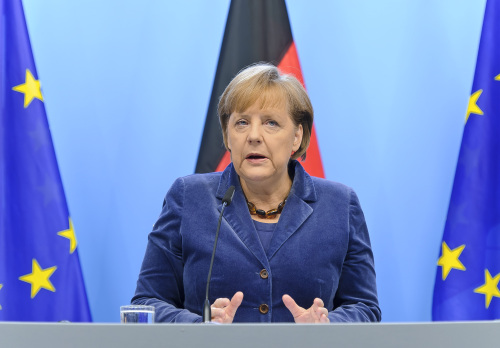 |
German Chancellor Angela Merkel (Bloomberg) |
BRUSSELS (AP) ― European leaders clinched a deal Thursday they hope will mark a turning point in their two-year debt crisis, agreeing after a night of tense negotiations to have banks take bigger losses on Greece’s debts and to boost the region’s weapons against the market turmoil.
After months of dawdling and half-baked solutions, the leaders had been under immense pressure to finalize their plan to prevent the crisis from pushing Europe and much of the developed world back into recession and to protect their currency union from unraveling.
The euro surged on the news of the full plan ― an early sign that investors may welcome it.
“We have reached an agreement, which I believe lets us give a credible and ambitious and overall response to the Greek crisis,” French President Nicolas Sarkozy told reporters after the meeting broke Thursday morning. “Because of the complexity of the issues at stake, it took us a full night. But the results will be a source of huge relief worldwide.”
The strategy unveiled after 10 hours of negotiations hit upon the three points expected for weeks. These include a significant reduction of Greece’s debts, a shoring up of the continent’s banks, partially so they could sustain losses on Greek bonds, and a reinforcement of a bailout fund so it can serve as a 1 trillion euros ($1.39 trillion) firewall to prevent larger economies like Italy and Spain from being dragged into the crisis.
After several missed opportunities, the hashing out of a plan was a success for the eurozone, but the strategy’s effectiveness will depend on the details, which will have to be finalized in the coming days and weeks.
“Will the sound of 1 trillion euros do the trick and ‘wow’ the markets or will the markets perceive this as smoke and mirrors?” Heather Conley, director of Europe program for the Center for Strategic and International Studies, asked before the official announcement of the plan. “If the past two years has told us anything, it never appears to be sufficient.”
The most difficult piece of the puzzle proved to be Greece, whose debts, the leaders vowed, would fall to 120 percent of its GDP by 2020. Under current conditions, they would have ballooned to 180 percent.
To achieve the reduction, private creditors will be asked to accept 50 percent losses on the bonds they hold. The Institute of International Finance, which has been negotiating on behalf of the banks, said in a statement that it was committed to working out an agreement based on that “haircut,” but the challenge now will be to ensure that all private bondholders fall in line.
It said the 50 percent cut equals a contribution of 100 billion euros ($139 billion) to a second rescue for Greece, although the eurozone promised to spend some 30 billion euros ($42 billion) on guaranteeing the remaining value of the new bonds.
The full program is expected to be finalized by early December and investors are supposed to swap their bonds in January, at which point Greece is likely to become the first euro country ever to be rated at default on its debt.
“We can claim that a new day has come for Greece, and not only for Greece but also for Europe,” said Greek Prime Minister George Papandreou, whose country’s troubles touched off the crisis two years ago. “Let’s hope the worst is over.”
Since May 2010, Greece has been surviving on rescue loans worth 110 billion euros ($150 billion) from the 17 countries that use the euro and the International Monetary Fund since it can’t afford to borrow money directly from markets.
In July, those creditors agreed to extend another 109 billion euros ― but that plan was widely panned as not doing enough to right Greece’s finances and wean it from the bailout.
Now, in addition to 30 billion euros in bond guarantees, the eurozone leaders and IMF said they will give Greece 100 billion euros in new loans.
With the banks being asked to shoulder more of the burden, though, there were concerns they needed more money in their rainy-day funds to cushion their losses. So European leaders have asked them to raise 106 billion euros ($148 billion) by June.
The last piece in the complicated plan was to increase the firepower of the continent’s bailout fund to ensure that other countries ― like Italy and Spain ― don’t get dragged into the crisis. The third ― and fourth-largest economies of the eurozone are too large to bail out.
To that end, the 440 billion euros ($610 billion) European Financial Stability Facility will be used to insure part of the potential losses on the debt of wobbly eurozone countries like Italy and Spain, rendering its firepower equivalent to around 1 trillion euros ($1.39 trillion).
That should have the effect of making those countries’ bonds more attractive investments and thus lowering borrowing costs for their governments.
“These are exceptional measures for exceptional times. Europe must never find itself in this situation again,” European Commission President Jose Manuel Barroso said after the meetings.
In addition to acting as a direct insurer of bond issues, the EFSF insurance scheme is also supposed to entice big institutional investors to contribute to a special fund that could be used to buy government bonds but also to help states recapitalize weak banks.
Such outside help may be necessary for Italy and Spain, whose banks were facing some of the biggest capital shortfalls.
Using the insurance promise, the eurozone also hopes to attract big institutional investors from outside the eurozone, such as sovereign wealth funds, to contribute to a separate fund that would back up the EFSF.
Sarkozy was due to speak to Chinese President Hu Jintao later Thursday. On Friday, the head of the EFSF Klaus Regling will travel to China, which has huge cash reserves, to detail the insurance set-up.







![[Today’s K-pop] Blackpink’s Jennie, Lisa invited to Coachella as solo acts](http://res.heraldm.com/phpwas/restmb_idxmake.php?idx=644&simg=/content/image/2024/11/21/20241121050099_0.jpg)
